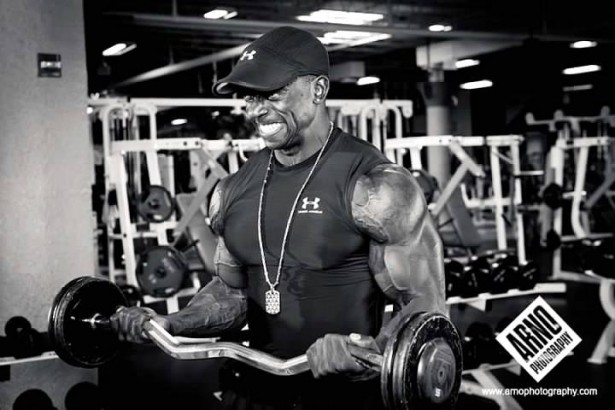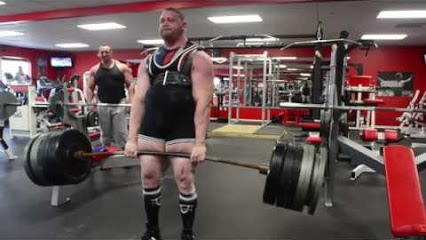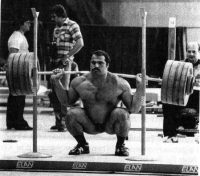Sets and reps.
It’s the foundation of muscle building. Has been since the very beginning. Whether it’s 5 x 5 for pure strength gains, 3 sets of 8-12 for hypertrophy or a single set of a hundred for that massive pump, the rep/set equation is the building block of any training program.
That, in itself, of course, doesn’t automatically make reps and sets the best way to train. It’s become the default training system because no-one knew there was an alternative.
Then along came Time under Tension.
Time under Tension (TUT) challenged what we’ve been doing in the gym since the days of Eugene Sandow by daring to suggest that counting reps was actually counterproductive – what we really needed to be doing was counting the total length of time a set lasted rather than worrying about any specific number of reps performed.
So, instead of aiming for 8 reps in a given set, you instead aim for a total time under tension of, say, 60 seconds. Once that time has elapsed you discontinue your set regardless of how many reps you have performed.
So, what gives here? Is it time to ditch the traditional rep based sets system in favor of timed sets, or is TUT not worth the time of day? Let’s investigate.
Time Under Tension Demystified
The total amount of time that our muscles spend under tension plays a key role in achieving optimal muscle building results. Tempo refers to the speed with which you perform your repetitions.
Tempo, especially as it relates to the negative part of the rep when you are lifting heavy, is crucial to maximum muscle stimulation.
Slowing down the reps makes you work a lot harder and places more emphasis on the working muscle. Squeezing at the top of the rep enhances the mind-muscle connection. It also increases your time under tension.
Muscles grow under muscle tension, so it makes sense to maximize the muscle tension. When you are constantly shocking your body with time under tension, your body will adapt a lot faster.
So, in order to maximize the effective time under tension, rather than counting your individual reps, you should count the time it takes to perform each rep. Specifically, you should be counting the seconds in your mind as you are performing the rep. Here is the ideal rep breakdown . . .
Concentric (positive part of the rep) = 3 seconds
Full contraction hold = 2 seconds
Eccentric (negative part of the rep) = 4 seconds
When you start focusing on your time under tension, as opposed to just getting through a pre-determined rep count, you will probably find that your weights will go down, especially when you begin to implement the 9-second rep system described above. That, believe it or not, is a good thing.
Your goal here is not to lift the heaviest weight. Rather, it is to maximally stimulate the working muscle group. By slowing way down and increasing the time under tension, you’ll be placing all the stress on the working muscle group, even if the weight is lighter. Always remember that the muscle doesn’t know how much weight is on the bar – all it knows is how hard it is being worked.
That’s the reason that you’ll see professional bodybuilders training with lighter weights than guys with far inferior physiques – they know how to use the weight they’ve got to max out the time under tension of the working muscle group.
In a typical rep-based set, the time to do a rep is 1-2 seconds up and 1- second down. When you do this workout after workout, your brain gets used to it and you are never forcing your body to adapt. The only way to stimulate muscle hypertrophy on a regular basis is to force your body to adapt. Increasing your time under tension will do just that.

Related: Best Muscle Building Supplements
Time Under Tension In Action
Here’s an example of how increasing your time under tension may look in a set of barbell curls . . .
A traditional rep based set for hypertrophy might involve doing 8 reps. If you’re doing them at a tempo of 1.5 seconds on the concentric part of the lift and another 1.5 seconds on the concentric part, it will take you 24 seconds to perform your set.
Now, you perform your set with a focus on tempo and time under tension. Your goal is no longer 8 reps but 50 seconds of time under tension. You perform each rep with 3 second concentric, 2-second static hold and 4-second eccentric tempo.
That means that each rep will take 9 seconds. Over the 50 seconds of your set, you’ll be performing about five and a half reps (though you won’t actually be counting the reps).
In the second set you’ve doubled your time under tension but performed two and a half fewer reps. So, which version of the set will be the most effective.
Science and common sense tell us that it will be the time under tension set. But don’t take our word for it – try it out for yourself. Perform your two sets as above and compare the amount of bicep activation and pump between them for yourself.
Magnitude of Tension
Of course time under tension is not the only variable required for muscle growth. There also has to be a sufficient magnitude of tension to induce muscle growth. You need to use enough weight to maximally stimulate the muscle. The weight that you end up using will be a matter of experimentation.
You need to find a resistance level that will allow you to maintain the training tempo described above while just reaching the designated time under tension. If your time under tension is 60 seconds and you could have continued on for another 15 seconds, then the weight is not heavy enough.
The amount of time under tension will vary in accordance with your weight training goals. Here’s a breakdown:
Strength – TUT = 1-30 seconds
Muscle Mass – TUT = 30-70 seconds
Muscular Endurance – TUT = 70+ seconds
Rest Period
Getting the right time between time under tension is another critical factor in maximizing hypertrophy. If you don’t get enough recovery time between sets, you’ll be too fatigued to lift maximally on your next set.
But, if you rest too long, your intensity level will taper off, and you won’t be able to stimulate new growth. What you need to achieve is adequate but not total recovery to allow you to be able to go again with maximum effort.
A number of studies have specifically looked into the ideal amount of rest time to elicit hypertrophy. A 1993 study by Häkkinen and Pakarinen concluded that a rest interval of 3 minutes induced significant increases in testosterone and growth hormone release within the body.
Later studies have supported the 3 minute rest interval for enhanced intensity and sufficient recovery to hit it hard on your next set.
Resting for 180 seconds between sets may seem like an inordinately long time. However, training in the manner described here is going to put new demands on your body that it isn’t going to be used to. If you are using a slow tempo and placing the target muscle group under a constant tension for 60 seconds, then you are definitely going to need 180 seconds recovery before doing it again.
Conclusion
So, are you ready to give Time Under Tension a try? Building muscle is all about experimenting to see what works best for your unique body and mindset. For the next six weeks, instead of doing your 3 sets of 8-12, or whatever rep system you’ve been training with, focus on time under tension.
Use a stopwatch. You can either purchase one or simply download a stopwatch onto your phone. Go with sets that are exactly one minute long. Remember to slow the tempo right down to a 3-2-4 count.
You’ll want to set the stopwatch to 65 seconds. This will give you time to set your watch and then get in position to start the set. At the end of the minute the timer will beep and that’s when your set will end.
You’re going to find this type of weight training brutal. It is totally counter to how you’re used to working out, so will challenge your mind just as much as your body. But it will give you a massive pump and it will shock your body into renewed growth.
About the author:
 Danavir Sarria is the founder of Iron Sensei, which is a fitness site that helps men burn fat and build muscle with action packed home workouts. For daily, free fitness and nutrition articles, go to: https://ironsensei.com/
Danavir Sarria is the founder of Iron Sensei, which is a fitness site that helps men burn fat and build muscle with action packed home workouts. For daily, free fitness and nutrition articles, go to: https://ironsensei.com/
Photo Credits: Arno Photography, Doug Larson Photography
[wp_ad_camp_2]
References
- LaChance, P.F., and Hortobagyi, T. Influence of cadence on muscular performance during push-up and pull-up exercise. J Strength Cond Res. 1994; 8(2), 76-79.
- Wernbom, M., Augustsson, J., and Thomeé, R. The influence of frequency, intensity, volume and mode of strength training on whole muscle cross-sectional area in humans. Sports Med. 2007; 37(3):225-64.
- Kraemer, W.J., and Ratamess, N.A. (2005). Hormonal responses and adaptations to resistance exercise and training. Sports Med. 2005; 35(4):339-61.
- Folland, J.P., Irish, C.S., Roberts, J.C., Tarr, J.E., and Jones, D.A. Fatigue is not a necessary stimulus for strength gains during resistance training. Br J Sports Med. 2002 Oct; 36(5):370-3.
- Staley, C. (2001, April 28). Russian training philosophy & Schroeder [Message 8271]. Retrieved from https://groups.yahoo.com/group/Supertraining/
- Weber, K.R., Brown, L.E., Coburn, J.W., and Zinder, S.M. Acute effects of heavy-load squats on consecutive squat jump performance. J Strength Cond Res. 2008 May; 22(3):726-30.
- Young, W. Neural activation and performance in power events. Modern Athlete and Coach. 1992; 30(1), 29-31.
- Häkkinen, K., and Pakarinen, A. (1993). Acute hormonal responses to two different fatiguing heavy-resistance protocols in male athletes. J Appl Physiol. 1993 Feb; 74(2):882-7.












